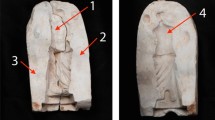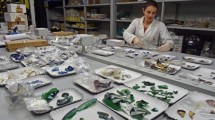Abstract
A method for investigating the forming technique of ancient ceramic vessels is presented. The recording, analysis, and comparison of the vessels' metrical properties by means of computer tomography, three-dimensional laser scanning, and solid-modeling software enables the identification of the applied manufacturing methods. A finite elements method-based simulation of the developed deformations during the vessels' manufacture offers significant insight into the applied shaping procedures. By making possible the exact recording of both the internal and external form of the vessels as well as the simulation of the forming procedure, the method represents a marked improvement to hitherto applied methods based on radiography. The method is applied on two early iron age ceramic jugs (oinochoai) found as offerings in tombs in excavations in Dion, Greece.












Similar content being viewed by others
References
Alexander, R. E., & Johnston, R. H. (1982). Xeroradiography of ancient objects: a new imaging modality. Archaeological ceramics (pp. 145–154). Washington, DC: Smithsonian Institution.
Bouzakis, K.-D., Efstathiou, K., Paradisiadis, G., & Tsouknidas, A. (2007). Experimental and FEM-supported investigation of wet ceramic clay extrusion for the determination of stress distributions on the applied tools' surfaces. Journal of the European Ceramic Society, 28, 2117–2127.
Costin, C. L. (1991). Craft Specialization: Issues in Defining, Documenting, and Explaining the Organization of Production. Archaeological Method and Theory 3, 1–56.
DEFORM-3D V8.0. (2008). Users' manual.
Foster, G. V. (1985). Identification of inclusions in ceramic artifacts by xeroradiography. Journal of Field Archaeology, 12, 373–376.
Gosselain, O. P. (2000). Materializing identities: an African perspective. Journal of Archaeological Method and Theory, 7(3), 187–217.
Hochstetter, A. (1984). Prähistorische Archäologie in Südosteuropa Band 3 Text, Kastanas: Ausgrabungen in einem Siedlungshügel der Bronze- und Eisenzeit Makedoniens 1975-1979, Die handgemachte Keramikschichten 19 bis 1. Berlin: Verlag Volker Spiess.
Jansen, R., Koens, H., Neeft, C., & Stoker, J. (2001). Scenes from the past: CT in the archaeology of ancient Greek ceramics. RadioGraphics, 21, 315–321.
Michelaki, K. (2008). Making pots and potters in the Bronze Age Maros villages of Kiszombor-Új-Élet and Klárafalva-Hajdova. Cambridge Archaelogical Journal, 18(3), 327–352.
Orton, C., Tyers, P., & Vince, A. G. (1993). Pottery in archaeology (Cambridge manuals in archaeology). Cambridge, UK: Cambridge University Press.
Pantermalis, D. (1997). DION, the archaeological site and the museum. Athens: Adam Editions.
Pantermalis, D. (1999). DION, the discovery. Athens: Adam Editions (in Greek).
Rice, P. M. (1987). Pottery analysis. London: The University of Chicago press. Ltd.
Rice, P. M. (1996a). Recent ceramic analysis: 1. Function, style, and origins. Journal of Archaeological Research, 4(2), 133–163.
Rice, P. M. (1996b). Recent ceramic analysis: 2. Composition, production, and theory. Journal of Archaeological Research, 4(3), 165–201.
Rye, O. S. (1977). Pottery manufacturing techniques: X-ray studies. Archaeometry, 19(2), 205–211.
Rye, O. S. (1981). Pottery technology: principles and reconstructions. Manuals on archeology 4 (pp. 68–70). Washington DC: Taraxacum.
SolidWorks. (2006). 2006 Users' guide manual. Concord, MA, USA: SolidWorks Corporation.
Tite, M. S. (1999). Pottery production, distribution, and consumption–the contribution of the physical sciences. Journal of Archaeological Method and Theory, 6(3), 181–233.
Acknowledgments
The research was conducted in the frame of “Archaeocop” EUREKA project, supported by the General Secretariat for Research and Technology of the Hellenic Ministry for Development. The authors would like to thank Prof. Klein and his collaborators (Fachhochschule Aalen, Germany) for their assistance in scanning jug No. 1 by a computer tomographer, as well as PV Engineering Co. (Athens, Greece) for their assistance in scanning jug No. 2 by a portable 3D laser device.
Author information
Authors and Affiliations
Corresponding author
Electronic supplementary material
Below is the link to the electronic supplementary material.
ESM 1
(DOC 29 KB)
Rights and permissions
About this article
Cite this article
Bouzakis, K.D., Pantermalis, D., Efstathiou, K. et al. An Investigation of Ceramic Forming Method Using Reverse Engineering Techniques: The Case of Oinochoai from Dion, Macedonia, Greece. J Archaeol Method Theory 18, 111–124 (2011). https://doi.org/10.1007/s10816-010-9081-0
Published:
Issue Date:
DOI: https://doi.org/10.1007/s10816-010-9081-0




